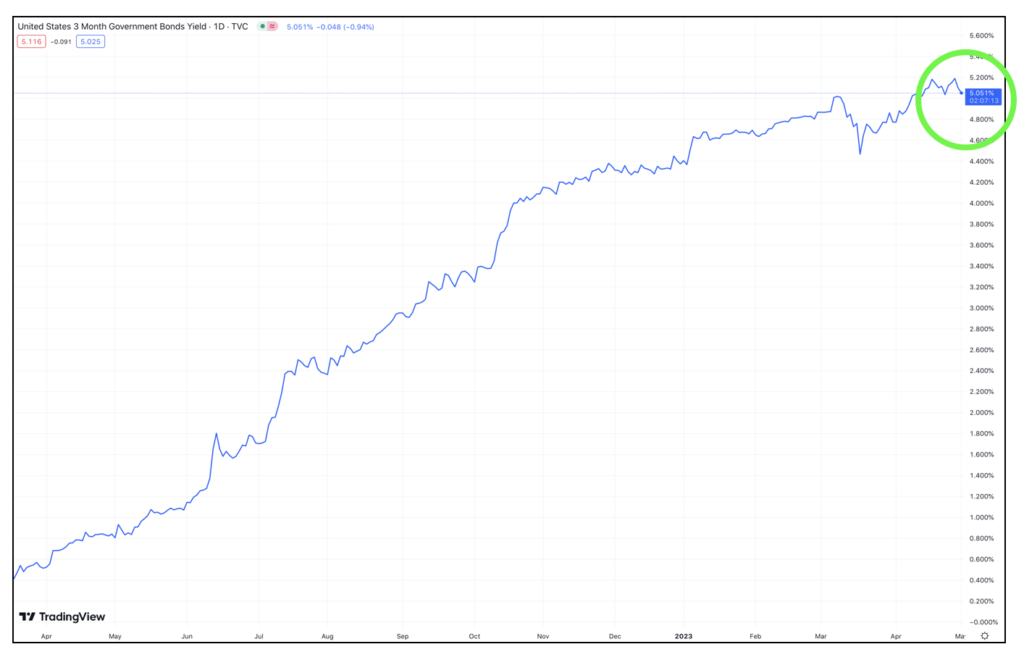The 26-week Treasury bill is now yielding over 5% … or 5x more than the average U.S. bank’s savings account offers.
We have a colleague who’s saving up to purchase his first home, and he has a couple concerns outside of the obvious ones like cash buyers squeezing first-time home buyers out of the market … surging mortgage rates … and whether he’ll be able to come up with a +20% down payment and avoid the racket that is private mortgage insurance.
But for today’s purposes, we wanted to focus on his concerns about (1) not being able to grow his savings fast enough and (2) not wanting to gamble it all away on risky investments.
Short-Term Investments
The best short-term investments are those that limit risk while still providing decent upside potential. In the last issue of The 101, we talked about how dollar-cost averaging can help grow your savings or investments through recurring purchases of safety-rated vehicles.
Once you identify those, it should be enough to convince you to move your money from a dead-end savings account (American banks offer an abysmal average APY of 0.37%) to an investment that provides more substantial returns.
On the flip side, never risk a nest egg on short-term investment that’ll destroy your chances of achieving that goal.
That means: No crypto, no meme stocks and no roulette wheels deciding your fate.
Fortunately, there are numerous safety-rated, short-term investments that provide decent returns and low-to-no risk. CDs, high-yield savings accounts and money market accounts come to mind.
But today, we want to talk about making an investment with the backing of the U.S. federal government, which equates to near-zero risk.
U.S. Treasurys
A government Treasury is a form of bond issued by the government to support public spending. It includes a commitment to pay interest (more on that in a bit) and to repay the face value on the maturity date.
Most importantly, Treasurys are considered risk-free because their repayment is backed by the full commitment and credit of the U.S. federal government. Unless the government goes belly-up, the money you use to buy Treasurys is safe.
What’s the catch? They take time. Like watching paint dry. Or a tortoise race. Or a trio of sloths go 12 rounds.
The Three Types of Treasurys
With Treasurys, you’re investing in safety first, profit potential second.
They aren’t going to take you on the proverbial moonshot ride. But they also won’t leave you worrying about risking that $10,000 you worked so hard to save.
Leave the YOLO trading in GameStop or AMC to the Lambo-loving dreamers. If you have plans of purchasing a house in the next year … an engagement ring … or even a car, you want slow, steady and safe investments — like the three categories of U.S. Treasurys provide:
- Treasury bills: shortest term government-issued securities, with maturity dates of four, eight, 13, 26 and 52 weeks.
- Treasury notes: longer than T-bills, but shorter than bonds, with terms including two, three, five, seven and 10 years.
- Treasury bonds: the longest to mature of government-issued securities, with terms including 20 or 30 years.
And right now, those Treasurys are providing …
The Best Interest Rates in Years
In early March, the yield on the 3-month Treasury was over 5%, the highest level since 2007. For context, that was the year High School Musical 2 was the second-best selling album and Walt Disney Studios thought the movie Wild Hogs was a good idea.

This week, the 26-week T-bill is offering 5.09%!
These short-term bills are an excellent way to put idle cash to work. So here’s how you can get your hands on some.
How to Purchase T-Bills
Unlike Treasury notes, which are auctioned monthly, four-week, eight-week, 13-week and 26-week Treasury bills are auctioned weekly. You can see the auction calendar here.
You can purchase them directly through TreasuryDirect.gov, and once you do, you can either hold them until the date of maturity or sell them. There is a $100 minimum purchase for T-bills, and they are sold in increments of $100.
Here are the steps:
- From the Treasury Direct website, click on “Open a New Account.”
- Next, click on the “BuyDirect” tab, then select “Bills – Short-term securities of 1 year or less.”
- From the “Purchase Information” list, choose the T-bill you’d like to purchase.
- Enter the purchase amount.
- Lastly, choose whether or not you’d like to set up a recurring investment — like we discussed earlier this month in The 101, with a focus on dollar-cost averaging. From there, confirm your purchase and enjoy your zero-risk gains.
TL;DR
If you’re saving for a big purchase, or if you just can’t stomach the thought of investing in higher-risk equities, U.S. Treasurys offer a zero-risk option with interest rates that are higher than they’ve been since 2007.


One Response